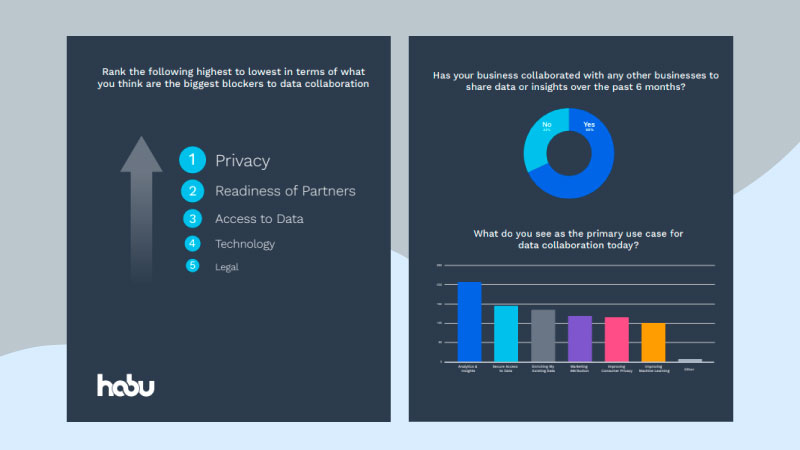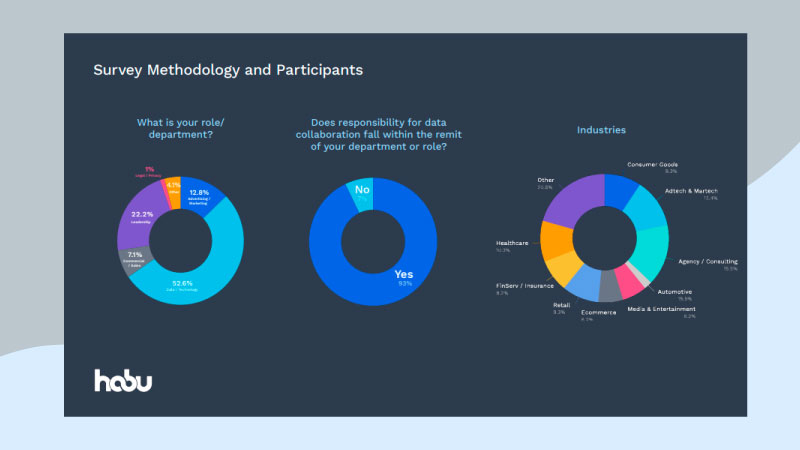With more concerns around privacy and cookieless tech platforms, businesses are turning to data collaboration solutions to adapt to the new advertising landscape. So, what does the data collaboration space look like right now?
Habu surveyed 266 individuals across industries and roles with the goal of understanding owners of data collaboration initiatives, current data collaboration practices, and future data collaboration plans.
Data Clean Rooms Are A Newer Data Collaboration Tool
Data clean rooms are one of the newer data collaboration solutions but almost half of respondents (47 per cent) stated that their company had used clean rooms. Businesses in industries such as CPG, Retail, and Media and Entertainment showed the highest adoption of clean rooms.
Over two thirds of respondents (68 per cent) indicated that their company had collaborated with another company in the last twelve months to share data or insights. Additionally, respondents identified that the most common use case for data collaboration is analytics and insights, followed by securing access to data, and then enriching existing data
Early Adoption Of Businesses Using Data Collaboration/ Data Clean Rooms
While the data collaboration industry is still maturing and existing approaches continue to evolve, businesses have been adopting data collaboration solutions to uncover new insights and provide their teams with better analytics.
Over two-thirds of respondents (68 per cent) indicated that their company had collaborated with another company in the last twelve months to share data or insights. Additionally, respondents identified that the most common use case for data collaboration is analytics and insights, followed by securing access to data, and then enriching existing data.

The report showed that in terms of obstacles to data collaboration, privacy was identified as the biggest blocker. This is not surprising, as businesses seek to maintain the privacy of their customers and breaches in privacy can lead to material impact in business growth and brand credibility. After privacy, the most common blockers to data collaboration are readiness of partners and access to data. Building a data collaboration practice is not just about getting one partner on board, but businesses may be looking for solutions that can scale across many partners. New data collaboration solutions that can help businesses easily onboard partners, identify use cases, and deploy use cases at scale will be key in unlocking shared insights.
Data Collaboration Practices
Over two thirds (70 per cent) of respondents see the level of data collaboration in their company increasing over the next 12 months and almost 80 per cent of companies plan to collaborate with other businesses to share insights or data in the year ahead.
The Retail, CPG, and Media and Entertainment industries are seeing the biggest increase in collaboration as CPG companies look to enrich their customer profiles and improve measurement by turning to the high-fidelity data that Retailers and Media companies are offering in their clean room environments.

Foundation For The Future
As companies embrace the ecosystem changes upon us, data collaboration is increasingly becoming a more critical component of data- driven strategy empowering brands to unlock new data and insights from partners that deliver better experiences for their consumers and drive new mutually beneficial growth for their businesses. And with the growing adoption of data collaboration solutions, such as data clean rooms, the number of collaborations is set to skyrocket in the months and years ahead, enabling brands and their partners to come together to better understand, target, and measure customer behaviour and accelerate time to insight without compromising control and privacy.
If you liked reading this, you might like our other stories
The Digital Certificate Conundrum
What’s the Next Tech Disruptor?









